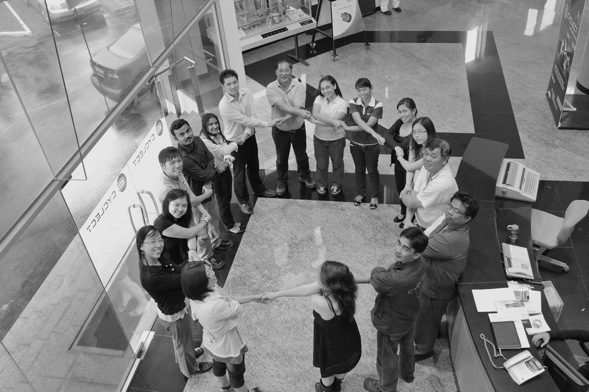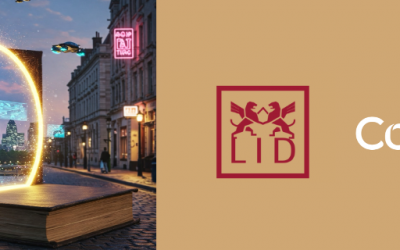In the novel The Pillars of the Earth, historical fiction author Ken Follet vividly described a village life that was united by the common goal of building a cathedral. Though it was not based on a historical account, the novel was well researched and presented an insightful view of how an identity-based objective – in this case a cathedral – can unite people and inspire incredible creativity. From an Asian perspective, an equally insightful piece for how temples like Borobudur would be interesting in terms of how they have inspired their communities in terms of architecture and innovation.
Some of the best companies in the world use their brand identity to attract and retain talent. By understanding what the identity means to them, employees are given a sense of ownership in the brand, which makes them less likely to leave the company. For example, Facebook’s staff express their thoughts using Facebook lingo. The names of their products reflect their way of thinking and is something that their staff can identify with. Google takes it a step further and has a dedicated group of designers who regularly reinterpret the brand identity through doodles, sometimes turning it into a highly influential tool that can create media buzz. During this year’s Easter, Google created a furore when it decided to dedicate the design of Google’s logo to Cesar Chavez, a labour activist rather than the typical symbols associated with Easter. Controversy aside, such creativity and flexibility with their identity reflects what the company appreciates and serves to build a connection with existing and potential employees. The influence it has in popular culture also adds to their attractiveness as a company. These examples show that an effort to turn your corporate identity into something meaningful and powerful increases a sense of belonging and builds connection. As a start, here are 3 ways in which you can improve your brand identity to make it more influential:
1. Make it meaningful
Many companies in Asia assume that a brand identity is simply their logo, serving little purpose other than to be functional representations of the company in signage. It is not surprising when only the management could explain the rationale or meaning of their logos. This is a wasted opportunity, as logos are a powerful way to succinctly communicate the purpose of the company. If your logo lacks more than a functional association, then consider redesigning the logo to match the direction and vision of the company. A basic principle is to treat the logo like a national flag where it represents the nation and evokes emotion in the citizens.

The new logo and tagline “Completely Possible” inspired by the company mindset of being able to deliver despite difficult challenges.
One example is our work with Cyclect. Their old logo represented an electrical generator, which alludes to the industry they are in. However, that logo no longer accurately portrayed their company, which has grown into diverse business interests. As part of their rebranding, a new logo had to be created to communicate the new direction of the company. The new logo was formed by inter-connecting ‘C’s to represent the different business units. This also served as a reminder to the group’s different subsidiaries that their strength lies in working together to resolve incredible challenges.
2. Build practices
Creating a brand identity is not enough if you do not create corporate practices to make it stick in the employees’ minds. An identity is a great opportunity to remind everyone of the journey ahead and corporate practices are a good way to help employees remember what the brand identity stands for.
We created a branded practice to associate linking hands to the concept of partnership as a symbol of Cyclect’s logo. In this way, the action becomes a constant reminder of their corporate identity and what their tagline means. It made it simple for all staff to explain the meaning of the logo to others. As a joint activity, it builds positive association.
3. Build association
Allow some experimentation with the brand identity among employees, as contribution from the ground encourages a sense of ownership. It is important to get all departments to think of ways to use the visual identity to express their thoughts and aspirations. This encourages them to have a hand in developing corporate culture.
When we launched Cyclect’s logo within the company, we wanted all 400 of their employees to be part of the process. To do that, we created a mosaic wall that carried a distinctive visual language inspired by the logo. Before their annual dinner, staff were asked to pick a piece, sign it and place it into the wall. This signified their participation as a key piece of the company and reinforced their association to Cyclect. The wall would continue to remind all of them of the brand identity and its accompanying values. Substantiated by the growth of media sharing platforms like Instagram and Pinterest, the role of imagery and storytelling become powerful tools in identity-building. To fully profit from such an exercise, companies need to take a strategic approach to involve all of its employees. The higher level of involvement will result in building stronger association and instilling a deeper sense of pride in their work. This then makes it easier for people to commit to the organisation and be more willing to build new “cathedrals” of innovation.
Lawrence Chong is the CEO at Consulus. This article is part of The Columnist, a newsletter by Consulus that offers ideas on business, design and world affairs. Get The Columnist in your inbox!






